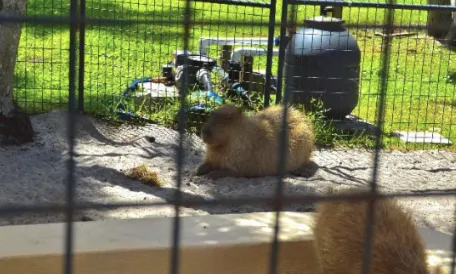

Capybara
Monica & Richard
Discover the world's largest rodent species.
Meet the capybara, the gentle giant of the rodent family!
Overview:
• Capybaras are native to South America, particularly found in savannas, dense forests, and near bodies of water. Their habitat spans from Panama to northern Argentina.
• Within the rodent family, capybaras are closely related to guinea pigs and rock cavies.
• They thrive in various environments across South America, including grasslands, marshes, and riverbanks.
Physical Description: The capybara is an impressive rodent known for its large size and semi-aquatic lifestyle. It boasts
a sturdy, barrel-shaped body covered in coarse, brownish fur, with lighter patches on the face
and belly. Their webbed feet aid in swimming, making them adept in aquatic habitats.
Capybaras also have small ears, eyes positioned high on their head for enhanced vision, and
short, blunt snouts.
Diet and Eating Habits: Capybaras are primarily herbivorous, feeding on a diverse array of plant materials such as
grasses, aquatic plants, and fruits. Their specialized digestive system allows them to efficiently
process tough vegetation, making them essential herbivores in their ecosystem. They are mostly
active during the early morning and late afternoon, grazing on vegetation near water bodies.
Behavior and Personality: Known for their sociable nature, capybaras are often found in large groups known as herds,
consisting of up to 100 individuals. They are highly social animals, engaging in grooming
behaviors and emitting various vocalizations to communicate within their group. Despite their
size, capybaras are peaceful creatures, often forming symbiotic relationships with other species,
such as birds and caimans, which benefit from their presence.
Domestication and Uses: While not fully domesticated, capybaras are sometimes kept in captivity for educational and
recreational purposes. In some regions, they are hunted for their meat and hide, although this
practice is regulated due to conservation concerns. Additionally, capybaras contribute to
ecotourism, attracting visitors to observe their unique behaviors in their natural habitat.
Cultural Significance: Capybaras hold cultural significance in various South American societies, symbolizing traits like
tranquility and adaptability. In indigenous folklore, they are revered as symbols of water and
fertility, featuring prominently in myths and rituals. Their gentle demeanor and communal
lifestyle have earned them admiration and respect among local communities.
Economic Importance: While not extensively exploited for economic purposes, capybaras contribute to local
economies through ecotourism and regulated hunting practices. In some regions, their meat is
consumed as a traditional delicacy, while their hide is used in crafting indigenous artifacts and
clothing. However, conservation efforts are crucial to ensure sustainable utilization of capybara
resources.
Conservation Status: Capybaras are currently listed as "Least Concern" on the IUCN Red List, thanks to their wide
distribution and stable population throughout South America. However, habitat loss and
hunting pressure pose localized threats to certain populations, warranting continued
conservation efforts to safeguard their long-term survival.
Takeaway:
The capybara, with its unique adaptations for aquatic life and sociable behavior, plays a vital role
in South American ecosystems and cultures. While their conservation status is relatively stable,
ongoing efforts are needed to address threats to their habitat and ensure their continued
presence in the wild. As symbols of tranquility and adaptability, capybaras serve as ambassadors
for the importance of coexisting harmoniously with nature.
